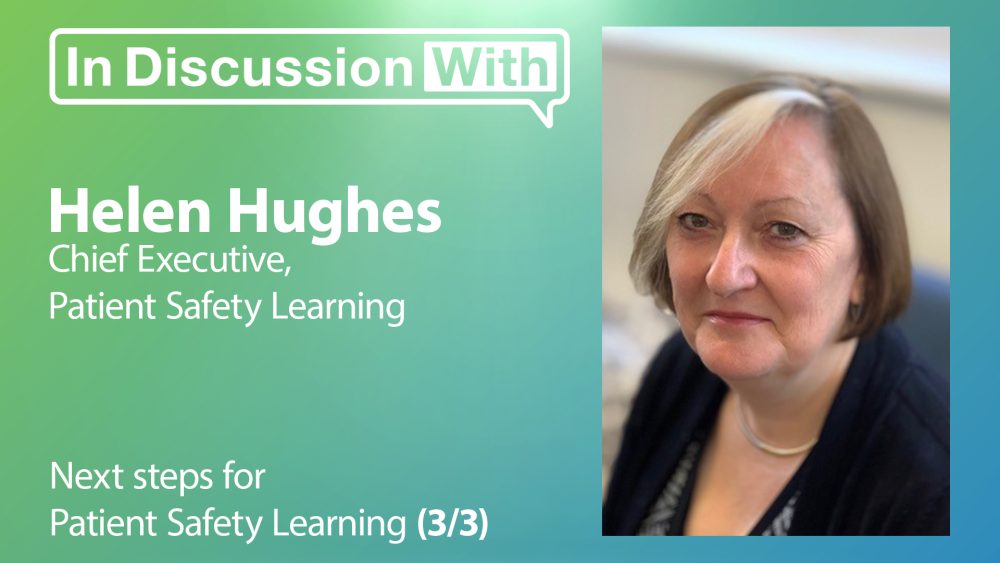Advertisment
Next steps for Patient Safety Learning

Helen Hughes, Chief Executive of Patient Safety Learning reflects on what has been learned over the past two years in the field of patient safety and outlines some of the priorities for the future.
Early in the coronavirus pandemic Patient Safety Learning recognised that staff safety was also a patient safety issue. For example, staff who could not access appropriate personal protective equipment (PPE) were putting themselves at risk and therefore potentially also putting patients at risk. “This was reflected in World Patient Safety Day last year – that patient safety and staff safety are really two sides of the same coin [and] we need to stop thinking them as entirely separate things”, says Ms Hughes.
In fact, the organisation used the time when people were unable to get out and about to develop a major policy report called A Blueprint for Action that builds on thinking and research over the past 15 to 20 years. Ms Hughes says: “We were trying to answer the question, “If we know what we know now, compared to 20 years ago, and … the system is responding by taking more action, why have we still got the same level of harm? Why is harm so persistent?” So, we built on the knowledge in A Blueprint for Action and one of the initiatives … that we called for was the development of patient safety standards for organisations”. A useful analogy is the fire safety strategy that every Trust will have. This is basically a policy framework that sets out “what ‘good’ looks like”. The organisation’s performance can then be reviewed and monitored against the standards to make sure that the policy has been implemented in an effective way. “You don’t have to have any of that for patient safety – there isn’t that framework”, says Ms Hughes.
Ms Hughes also draws attention to the recent World Health Organization report entitled, Implications of the Covid-19 pandemic for patient safety: a rapid review, to which she contributed. “It’s a WHO rapid review on covid-19 and patient safety – the implications – and I would encourage people who are interested in this field to pick up and learn from that”, she says.
The Patient Safety Learning Hub has recently celebrated its two-year anniversary but there is still more work to be done.

Mind the Implementation Gap
A recent report called Mind the implementation gap: The persistence of avoidable harm in the NHS deals with addressing the ‘no do gap’. There is now a mass of knowledge about the causal factors of unsafe care, including investigations, inquiries, coroners’ reports, the work of the Healthcare Safety Investigation Branch and a plethora of insight testimonies from patients and families. “Let’s start applying that knowledge for improvement. Let’s take that knowledge and act on it. So, we don’t want to see more inquiries into maternity care that has failed mothers, families [and] babies. We want the recommendations from those reports and from those inquiries be implemented”, says Ms Hughes.
The report identified the need for a monitoring or oversight body in the UK that follows up recommendations, operating as a safety management system. The problem is that “we’re not we’re not designing our system as a learning system. We’re not acting on our insight and then evaluating what works and then sharing that knowledge. So, let’s turn it into a more effective learning system”, she says. Part of PSL’s role will be to try to influence through policy, working with parliamentarians and accountability frameworks, working with national bodies and also working with organisations on the ground to help them assess what more they need to do and help them put plans in place to deliver that, she adds.
Healthcare professionals
“We should be providing healthcare professionals with the environment that enables them to do their job safely and to provide safe care for their patients and families – and we’re not doing that as well as we ought to. We know from the scale of avoidable harm [that] more needs to be done so I think I think it’s almost a recognition that we need to transform ourselves to be able to provide people with the environment to do the right thing more readily”, says Ms Hughes. It is not only a matter of learning from situations when things go wrong but also sharing good practice. “There are lots of examples of where people are doing rather well [and] we need to share”, she says. Healthcare professionals are almost all interested in patient safety and need to understand how they can contribute further by sharing their experience. If they feel they’re in a supportive environment then it could be useful to raise their concerns, suggest improvements and create networks to work with colleagues. “The most effective way of improving safety is to work as an effective multi-disciplinary team – there is no doubt about it”, she says.
Helen Hughes has held leadership roles in healthcare in the UK and the WHO, the National Patient Safety Agency, Equality and Human Rights Commission, Parliamentary Health Services Ombudsman and the Charity Commission. Helen’s previous leadership roles in patient safety include, Director of Operations of the National Patient Safety Agency and \executive lead of the global ‘Patients for Patient Safety’ programme at the WHO.
Patient Safety Learning’s the hub is an award-winning platform to share learning for patient safety. It offers a powerful combination of tools, resources, stories, ideas, case studies and good practice to anyone who wants to make care safer for patients. Its communities of interest give people a place to discuss patient safety concerns and how to address them. Membership is free – you can register at www.pslhub.org.
Read and watch the full series on our website or on YouTube.





